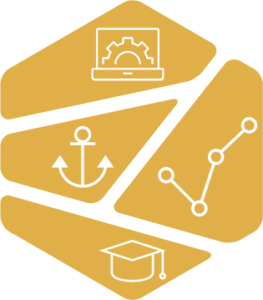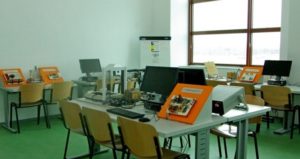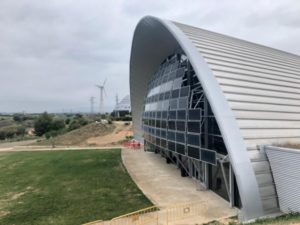In theory Community Building is easy, in practice it is like digging for gold
By Bonnie Murphy, Behavioral Scientist, GECO GLOBAL, Finland 13. August 2019
 A journey of “reading between lines” has started. The first step was a study of understanding the meaning of words said in the room and interpret what was said between the lines. A lot of qualitative data has been decoded layer by layer, in the search for golden phrases and important information to go into the E-LAND project.
A journey of “reading between lines” has started. The first step was a study of understanding the meaning of words said in the room and interpret what was said between the lines. A lot of qualitative data has been decoded layer by layer, in the search for golden phrases and important information to go into the E-LAND project.

Bonnie Murphy, Behavioral Scientist, GECO Global (Photo: Smart Innovation Norway)
In the crest for finding gold in community building, it is essential for the E-LAND project to identify the handles whereby we can untangle organisational knots and the people who hold the authority to do so. In particular, to find the cross-functional gatekeepers and influential forerunners to be able to unfold the demonstration site’s full potential.
The general goal of community building is to develop relationships and shift perspectives to create a shared vision between decision-makers, end-users, and technology developers.
Importantly, this process goes beyond simply having a list of stakeholders and organizational charts, and instead studies the multi-layered ecosystems in which a solution will be introduced to understand the deeper cultural, sociological, and psychological factors at play.
An agile model for community analysis
The Common Impact Model (CIM) represents a suite of methodologies for studying these community dynamics with the goal of creating an engaging roadmap that activates multiple stakeholder groups (e.g. company management, employees, students, professors, DSOs, regulators, local government).

Port of Borg, Norway (Photo: GECO Global)
This process begins by defining the technological, cultural, and theoretical scope of the communities based on data from site visits and other documentation.
Next, these inputs are analyzed and stakeholder needs are mapped. From these insights, pilot narratives and communication and engagement strategies are developed and applied via a “plan-do-check-act” cycle where community-building initiatives are tested, optimized, and adapted.
Recently, the CIM has been put into practice at the three E-LAND European pilot sites. Work package 3 leaders, Geco Global, spent several days at each pilot location (Port of Borg – Norway, Walqa Technology Park – Romania, and Valahia University of Targoviste – Spain) interviewing dozens of end-users and local stakeholders.
This step was essential in collecting the primary interview and ethnographic data that will bring to life the needs, challenges, and opportunities for community members at each site.

University Valahia of Targoviste, Romania (Photo: GECO Global)
Common needs at vastly different pilot sites
While each of these pilot locations represents a vastly different community, the systematic approach provided by the CIM has been proven to be agile enough to navigate these differences.
While the end-users and local stakeholders may vary, the fundamental questions put forth by the model remain the same: Who are the influencers who will serve as change agents, what are their energy needs, and what kind of governance structure is needed to sustain long-term change?

Walqa Technology Park, Spain (Photo: GECO Global)
Deliverable 2.3 provides an actionable workbook and complimentary guidebook that detail the first engagement milestones for each of these pilot sites based on this initial fieldwork. These recommendations represent the first building blocks that guide these communities towards a common green energy goal. Over the coming months, further milestones will be introduced; each reflecting the evolving green energy transition in each community.
Who is GECO Global?GECO Global is a consultancy in research and analysis, communication, marketing, and community engagement which include behavioral dynamics and stakeholder involvement. In particular, GECO Global are experts in the fields of demand response, energy efficiency, smart building, smart grid, and related new business models. Besides being a content provider to EU projects, GECO Global advises companies in the green transition, product innovation, sustainability governance, and the human factor. |
||
Social media
E-LAND updates

The E-LAND project aims to develop and demonstrate tools for energy systems to overcome the technical, business, and societal challenges associated with the creation of… (1 year ago)

E-LAND exploitation enhancement activities kickstarted for the final project year Multiple events were executed and many more are planned for the E-LAND project’s final year.… (1 year ago)

A central pillar of the E-LAND project's is risk management. The Norwegian consortium member, Institute for Energy Technology (IFE), implemented a risk management approach to… (2 years ago)

E-LAND H2020 is working with creating a toolbox that is designed to optimize and control multi-energy islands and isolated communities. The toolbox is structured in… (2 years ago)

Smart Innovation Norway together with the University of St. Gallen have developed a series of workshops that began in June 2021 and focused on the… (2 years ago)

About the pilot site: Port of Borg is situated in an industrial area on a small peninsula called Øra just outside Fredrikstad, Norway. Port work… (2 years ago)

Since the mid-1960s, the township of Auroville in Southern India has been striving for sustainable living and the realization of human unity in diversity. In… (2 years ago)